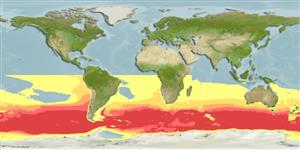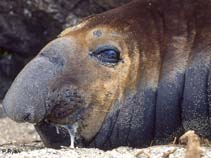Mirounga leonina (Linnaeus, 1758)
Southern elephant seal| Native range | All suitable habitat | Point map | Year 2050 |

|
| This map was computer-generated and has not yet been reviewed. |
| Mirounga leonina AquaMaps Data sources: GBIF OBIS |
Classification / Names आम नाम | उपशब्द | CoL | ITIS | WoRMS
Mammalia | Carnivora | Phocidae
Environment: milieu / climate zone / गहराई सीमा / distribution range पारिस्थितिकी
; गहराई सीमा 0 - 8000 m (संदर्भ 1394), usually 1000 - 5000 m. Polar; 0°N - 90°S, 180°W - 180°E
Distribution देश | ऐफ ऐ ओ क्षेत्र | Ecosystems | संयोग | भूमिका
Indo-Pacific, Atlantic Ocean and the Antarctic: Circumpolar in the Southern Hemisphere, Skeleton coast of Namibia around the Cape to Ilha Bazaruto in Mozambique. Polar, temperate.
Length at first maturity / आकार / Weight / Age
परिपक्व अवधि: Lm ? range ? - ? cm Max length : 685 cm TL पुल्लिंग / अलिंग; (संदर्भ 99323); 300 cm TL (female); अधिकतम प्रकाशित वज़न: 5.0 t (संदर्भ 99323); अधिकतम प्रकाशित वज़न: 5.0 t
Life cycle and mating behavior परिपक्व अवधि | पुनरुत्पत्ति | मछलीऔ का अंडे देना | Eggs | Fecundity | Larvae
Main reference
संदर्भ | संयोजक | सहयोगीयो
Jefferson, T.A., S. Leatherwood and M.A. Webber 1993 FAO species Identification Guide: Marine Mammals of the World. Rome, FAO. 320 p. + 587 figures. (संदर्भ 1394)
IUCN Red List Status
(संदर्भ 130435: Version 2025-1)
CITES status (संदर्भ 108899)
CMS (संदर्भ 116361)
Threat to humans
Human uses
मात्स्यिकी: व्यापारिक
FAO - मात्स्यिकी: species profile | FishSource | Sea Around Us
साधन
अधिक जानकारी
परिपक्व अवधि
Fecundity
मछलीऔ का अंडे देना
Eggs
Egg development
Larvae
इंटरनेट स्रोत
BHL | BOLD Systems | CISTI | DiscoverLife | FAO(मात्स्यिकी: species profile; publication : search) | Fishipedia | GenBank (genome, nucleotide) | GloBI | Gomexsi | Google Books | Google Scholar | Google | PubMed | Tree of Life | Wikipedia (Go, खोज) | Zoological Record



